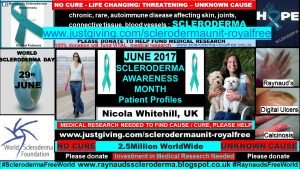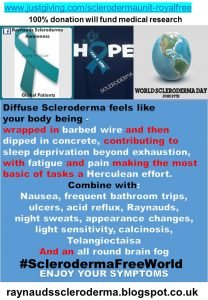Week 3 Scleroderma Awareness Month 2017: Patient Profiles, Medical Research, Areas of Current Interest
Written by |

The month of June is Scleroderma Awareness Month, with June 29 being World Scleroderma Day.
To further the theme of Rare Disease Day 2017 — “Research, where possibilities are limitless” — the focus of my Scleroderma Awareness Month campaign is “Research,” while also focusing on patient profiles from various countries, highlighting the crucial need for further investment in medical research, and of patients’ unmet clinical needs.
The patient profiles in the survey that I am conducting with patients worldwide show a uniformity in current unmet clinical needs to the scleroderma and Raynaud’s patient, a rare disease patient.
As I described in my column for Week 2, my personal drive is for global best management and treatment guidelines. Without a doubt, the global golden hallmarks for these are:
- Early diagnosis.
- Expert specialist centers.
- Access to innovative medicines.
So far, all of the patients included within the patient profile campaign highlight the crucial necessity for these three hallmarks to improve patient treatment. They also showcase the unmet clinical needs, and where medical research is slowly progressing.
At the 4th Systemic Sclerosis World Congress held in Lisbon, in 2016, The Journal of Scleroderma and Related Disorders (JSRD) was launched. This is the official journal of the World Scleroderma Foundation and the European Scleroderma Trials and Research group (EUSTAR).
Included within Volume 1, Number 1, the January–April 2016 issue, are the abstracts presented at the congress. I have made a summary of the subject headings below, and have summarized the content of each abstract, thereby showing the different areas of current research interest and focus. They are:
Session 1: Pulmonary involvement
Session 2: Ulcers
Lecture 1: “Macitentan responsiveness supports the validity of a murine model of pulmonary hypertension in scleroderma associated with altered TGFBETA/BMPRII signaling.”
Parallel Session 3: Common clinical situations with poor evidence-based data: How to manage?
Parallel Session 4: Advances in epigenetics and genetics
Parallel Session 5: Cardiac
Parallel Session 6: Current research in immunity/inflammation
Lecture 3: “Increased frequency of malignancies, and in particular breast cancer, synchronous to the onset of SSc in anti-RNA polymerase III antibodies positive patients: A EUSTAR multicentre study.”
Lecture 4: “Impaired Micronutrient Status In Patients With SSc”
Session 8: Roundtable SSc registries in the world
Lecture 5: “Survival and organ involvement in patients with limited cutaneous SSc and anti-topoisomerase antibodies: more like lcSSc or dcSSc?”
Parallel Session 9: Experimental models of scleroderma
Parallel Session 10: Outcome measures
Session 11: Emerging therapies
What does this mean to me, a long–term patient?
Although the discovery of a cure is unlikely to be of huge assistance to me since my disease level is stable, the subject contents of the abstracts are most encouraging. They show that an improvement in understanding of all aspects of the disease are being looked into with a “holistic approach.”
On a personal level, it is most rewarding for me to see some of the work I am involved with, via my role with the European Medicines Agency, being utilized in progressive efforts to improve or reach the SclerodermaFreeWorld goal. I am honored to be a member of the Scientific Advice Working Party at the EMA, where pharmaceutical companies and others seek, for example, advice on how to successfully move a drug used in clinical trials into acceptance and marketplace availability as a licensed brand.
I took the liberty to use DAY 12 of the patient profile campaign to highlight my experience, as this was my 44th birthday. I had a perfect day, and huge thanks to everyone who made it so special.
The 5th Systemic Sclerosis World Congress will take place Feb 15–17, in Bordeaux, France. This biannual event is the hub for the most up–to–date understanding of the entire scleroderma disease process.
What have the patient profile responses shown?
Overall, medical understanding as to the nature of the disease has improved immensely over the course of the last decade. However, due to the multi–complex body systems involved in the disease process, research still falls way behind in providing an understanding as to the cause, and effective treatments — things that can lead to a cure.
World Scleroderma Day
The countdown is on… June 29 is World Scleroderma Day. I will be presenting live on the Scleroderma News Facebook page: Please join me, and please post any questions or comments you would like to have discussed. In particular, I will be focusing on this year’s awareness campaign, as well as my 20–year anniversary of living with scleroderma and Raynaud’s, having initially been given a 15–month prognosis.
Please DONATE to help fund medical research at The Scleroderma Unit, where 100% of all of money received is used for medical research purposes only. Thank you.
Living the dream, hoping for a cure
#SclerodermaFreeWorld #RaynaudsFreeWorld
#RareDisease #Hope #Belief
Follow Raynaud’s Scleroderma Awareness Global Patients Facebook Page for the latest updates
***
Note: Scleroderma News is strictly a news and information website about the disease. It does not provide medical advice, diagnosis, or treatment. This content is not intended to be a substitute for professional medical advice, diagnosis, or treatment. Always seek the advice of your physician or other qualified health provider with any questions you may have regarding a medical condition. Never disregard professional medical advice or delay in seeking it because of something you have read on this website. The opinions expressed in this column are not those of Scleroderma News, or its parent company, Bionews Services, and are intended to spark discussion about issues pertaining to scleroderma.











Leave a comment
Fill in the required fields to post. Your email address will not be published.